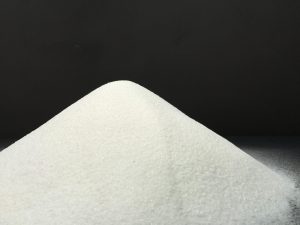
Production Process
Precipitated calcium carbonate: including light calcium carbonate and nano-calcium, generally using limestone as raw material, it is prepared through calcination, digestion, carbonization, separation, drying, grading, packaging and other processes.
Grinding calcium carbonate: referred to as heavy calcium, is produced by mechanically crushing natural calcite, limestone, chalk, shells, etc. The main process includes pulverization, superfine pulverization, classification and surface modification.
The pH of heavy calcium is 8-9,
Light calcium has a pH of 9-10.
Heavy calcium powder particles are irregular in shape, with edges and corners, rough surface, large particle size and wide distribution. Generally, calcite powder is in hexagonal crystal form, and marble powder is in cubic crystal form, which is mainly related to the place of origin.
Light calcium powder particles have regular shape and can be regarded as monodisperse powder with narrow particle size distribution. According to the different grain shapes, light calcium can be divided into spindle shape, square shape, diamond shape, spherical shape and so on.
In industry, light calcium, heavy calcium and nano-calcium carbonate are often judged initially by the difference in sedimentation volume. The larger the sedimentation volume, the smaller the particle size, the lighter the density and the higher the grade of the product. The sedimentation volume of heavy calcium is 1.1-1.4ml/g, that of light calcium is 2.4-2.8ml/g, and that of nano calcium carbonate is 3.0-4.0ml/g.
Heavy calcium products are generally made by physical crushing and grinding, with relatively more impurities, and the whiteness is generally 89% to 93%;
Light calcium is chemically synthesized with high purity, and the whiteness is mostly 92% to 95%.
Heavy calcium moisture is generally 0.2% to 0.3%, the moisture content is relatively low and relatively stable;
Light calcium moisture is generally 0.3% to 0.8%, and sometimes there will be certain fluctuations and instability.
Due to the large particles, smooth surface and small specific surface area of heavy calcium, the oil absorption value is low, generally around 40-60mL/100g;
Light calcium particles are fine, the surface is rough, and the specific surface area is large, so the oil absorption value is relatively high, generally around 60-90mL/100g.
The microstructure of light calcium is spindle-shaped, and its own oil absorption value is large, which can absorb components that promote flow in the formula, such as lubricants, plasticizers, coupling agents, dispersants, etc., so the fluidity is not as good as heavy calcium .
